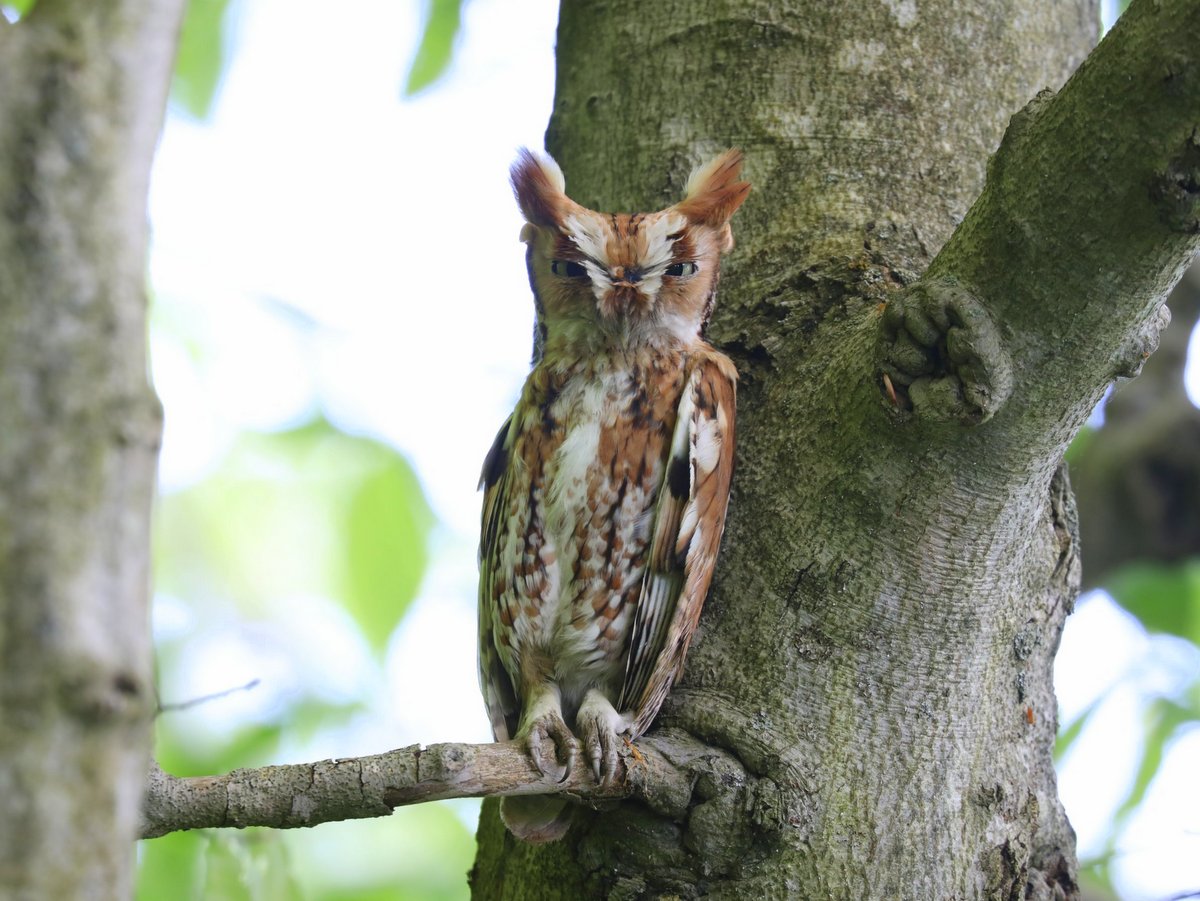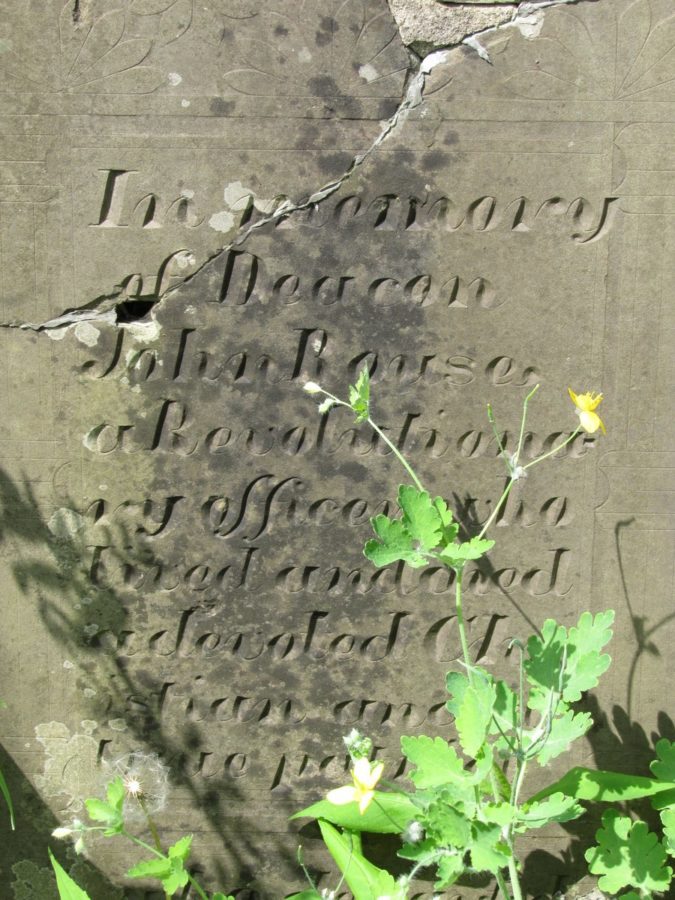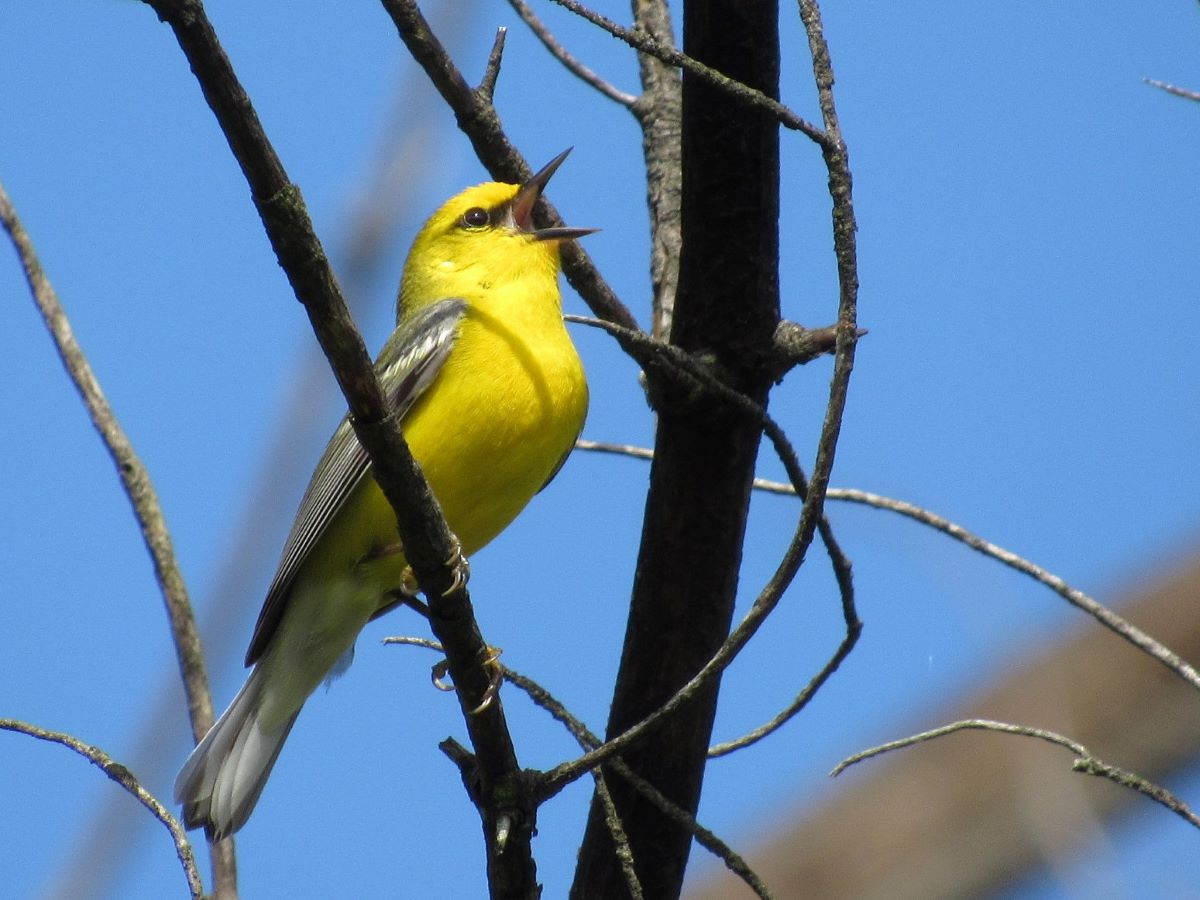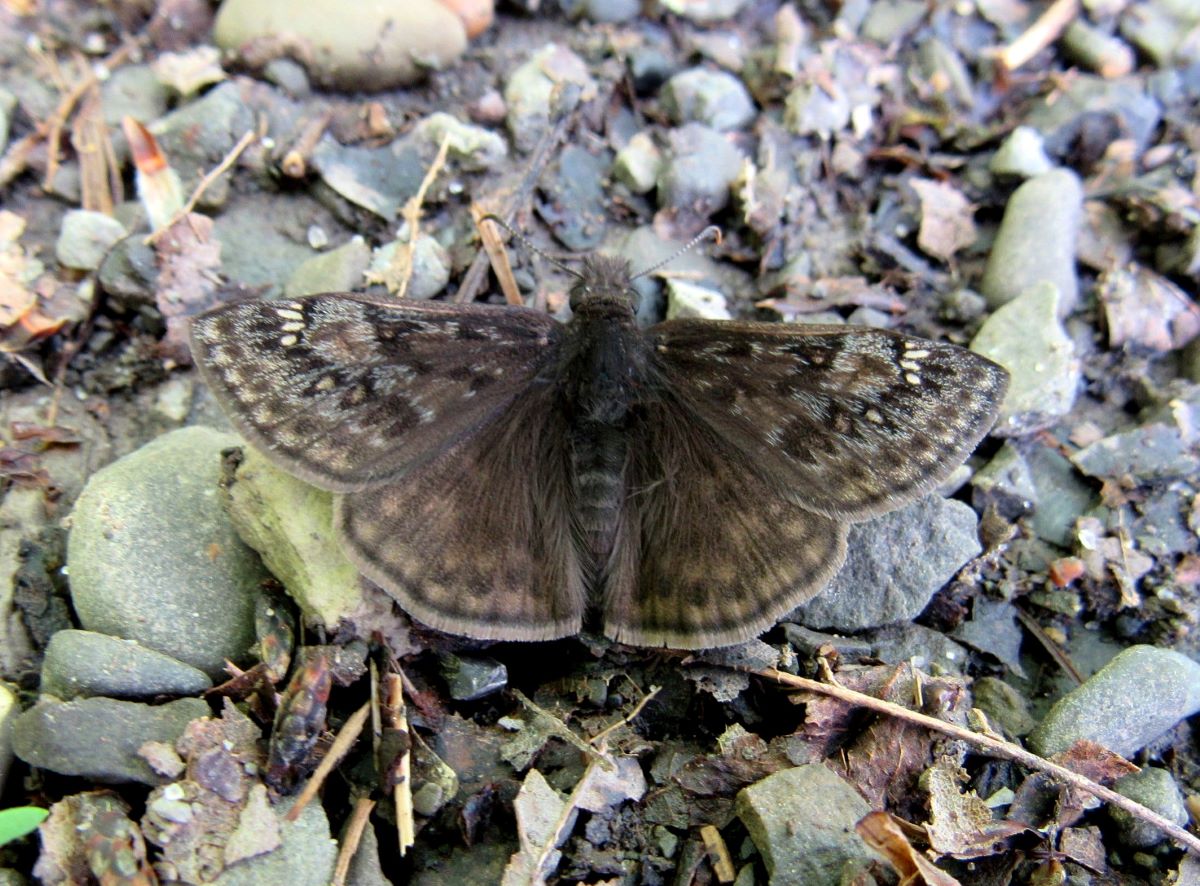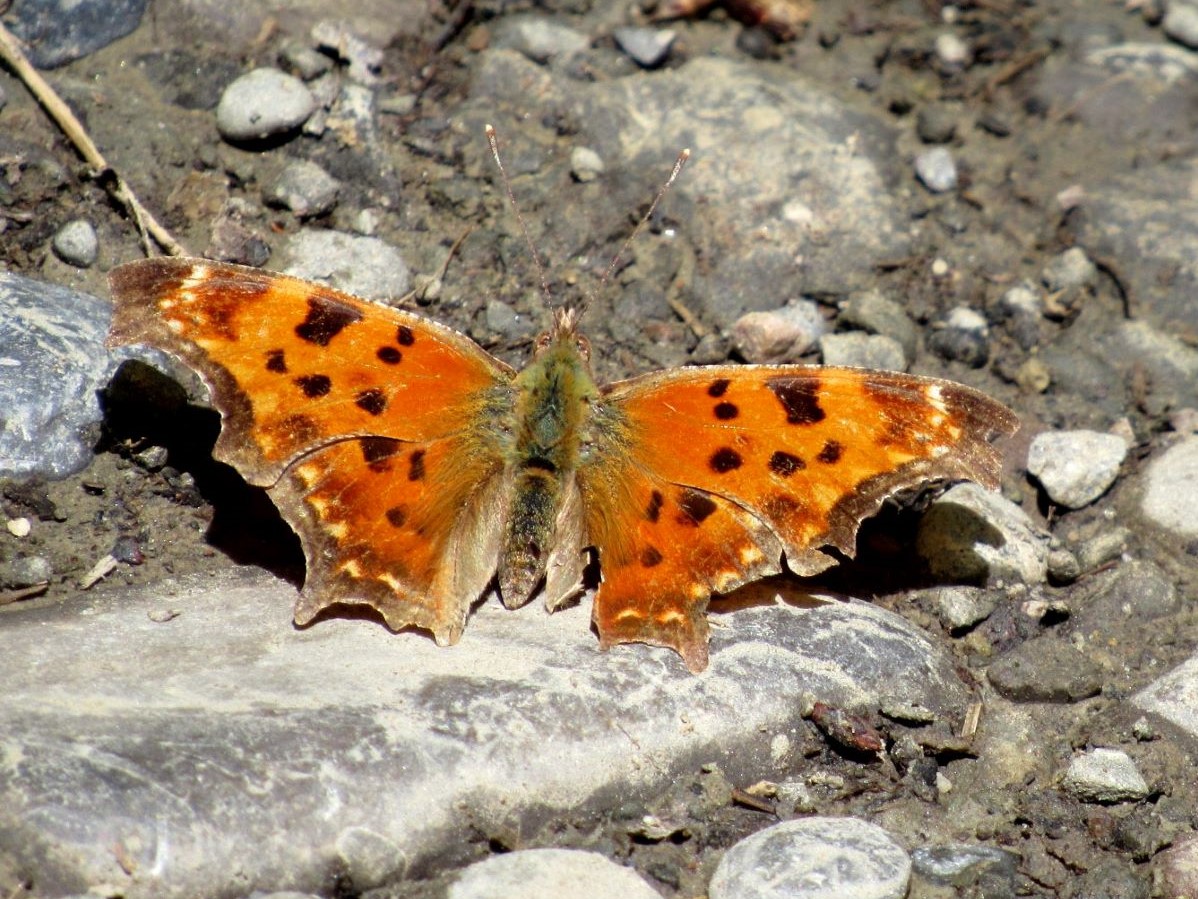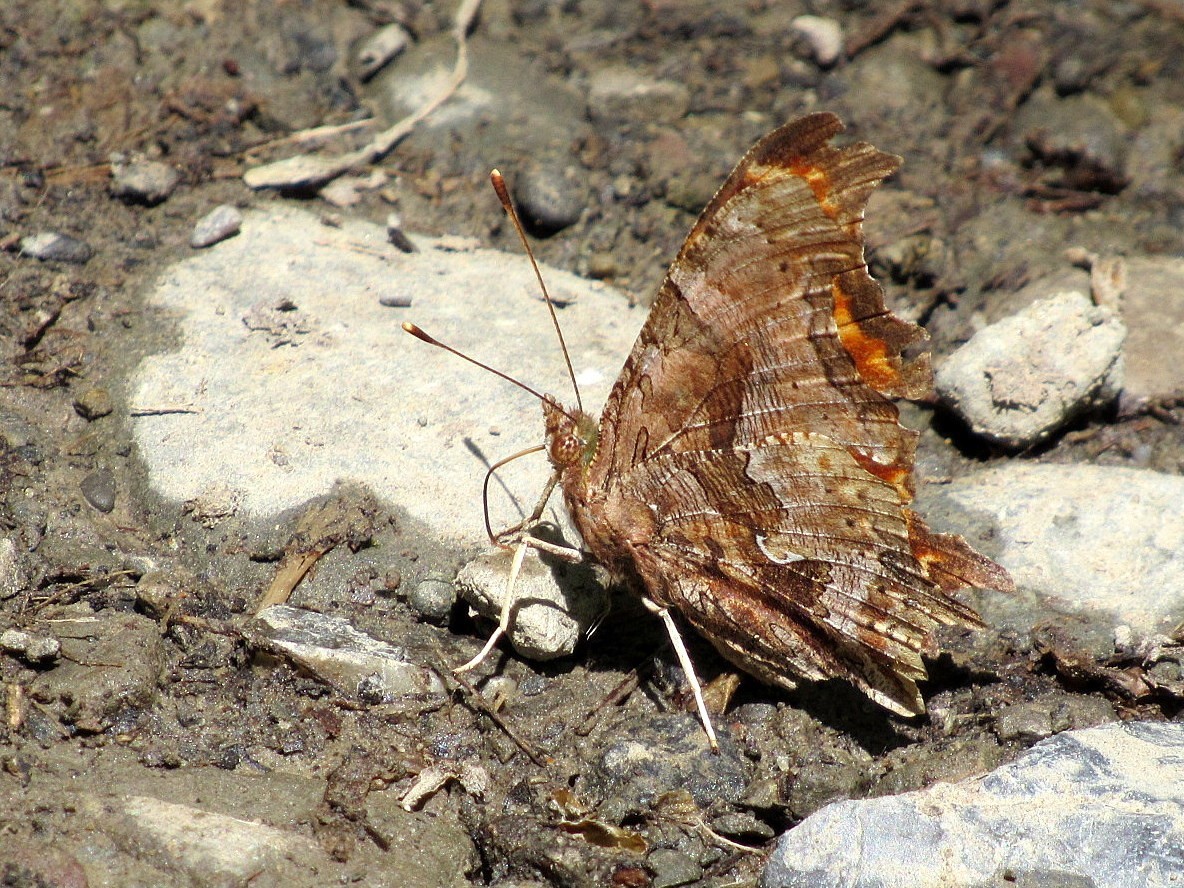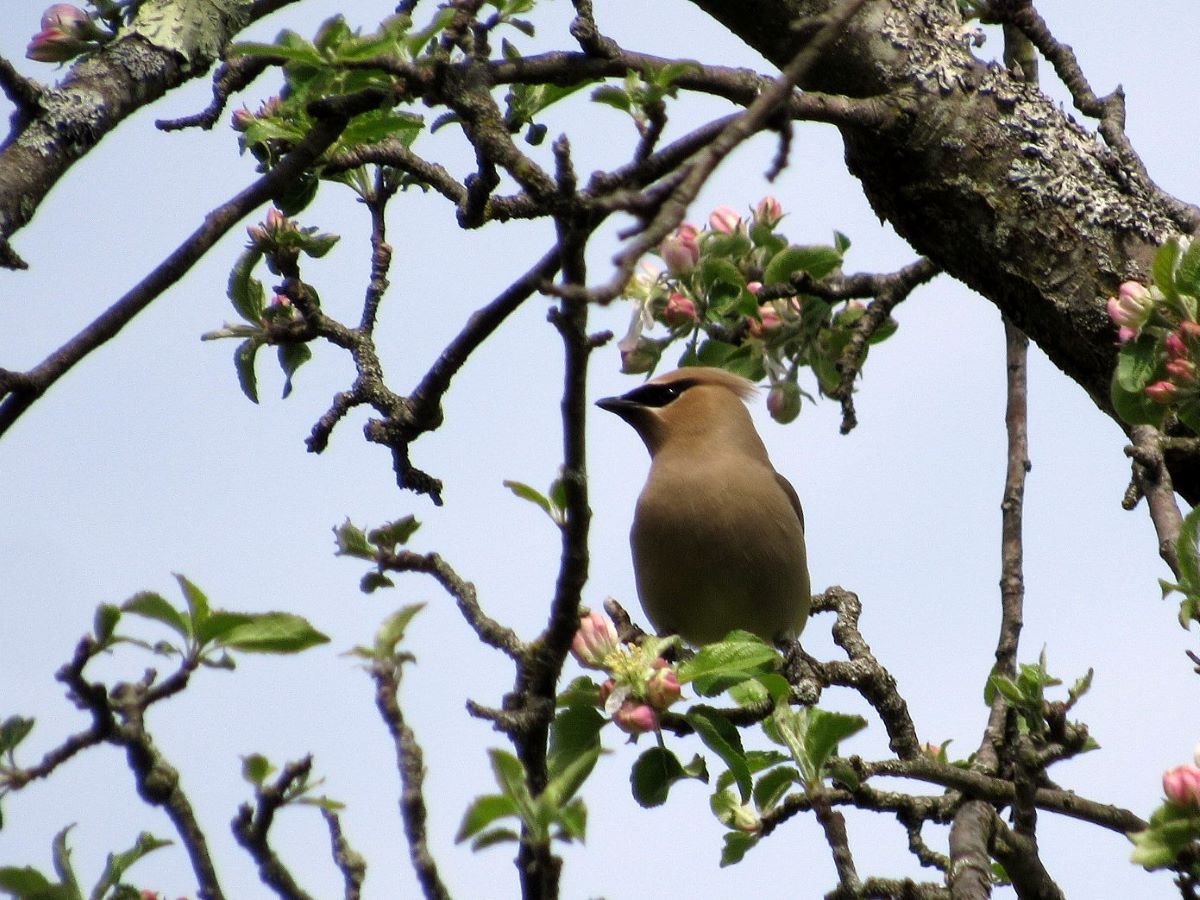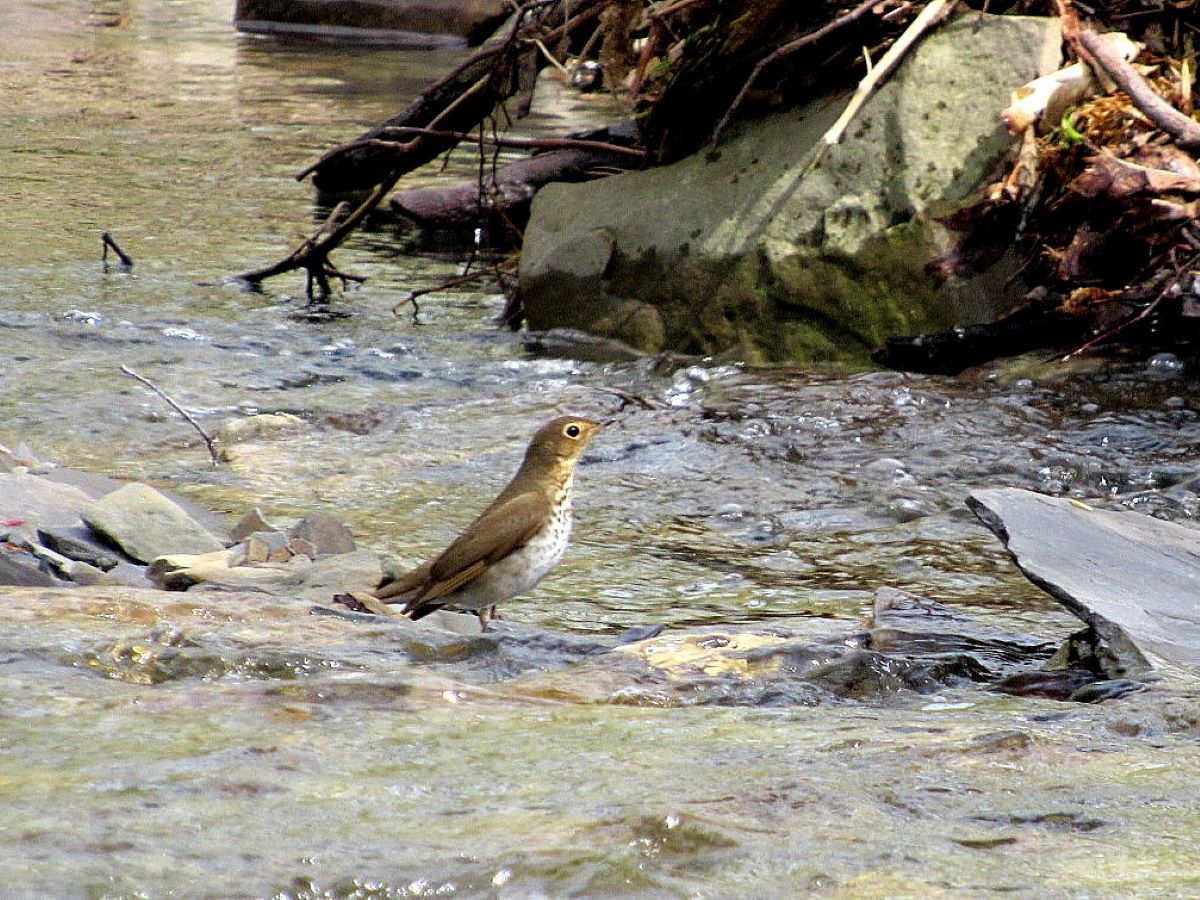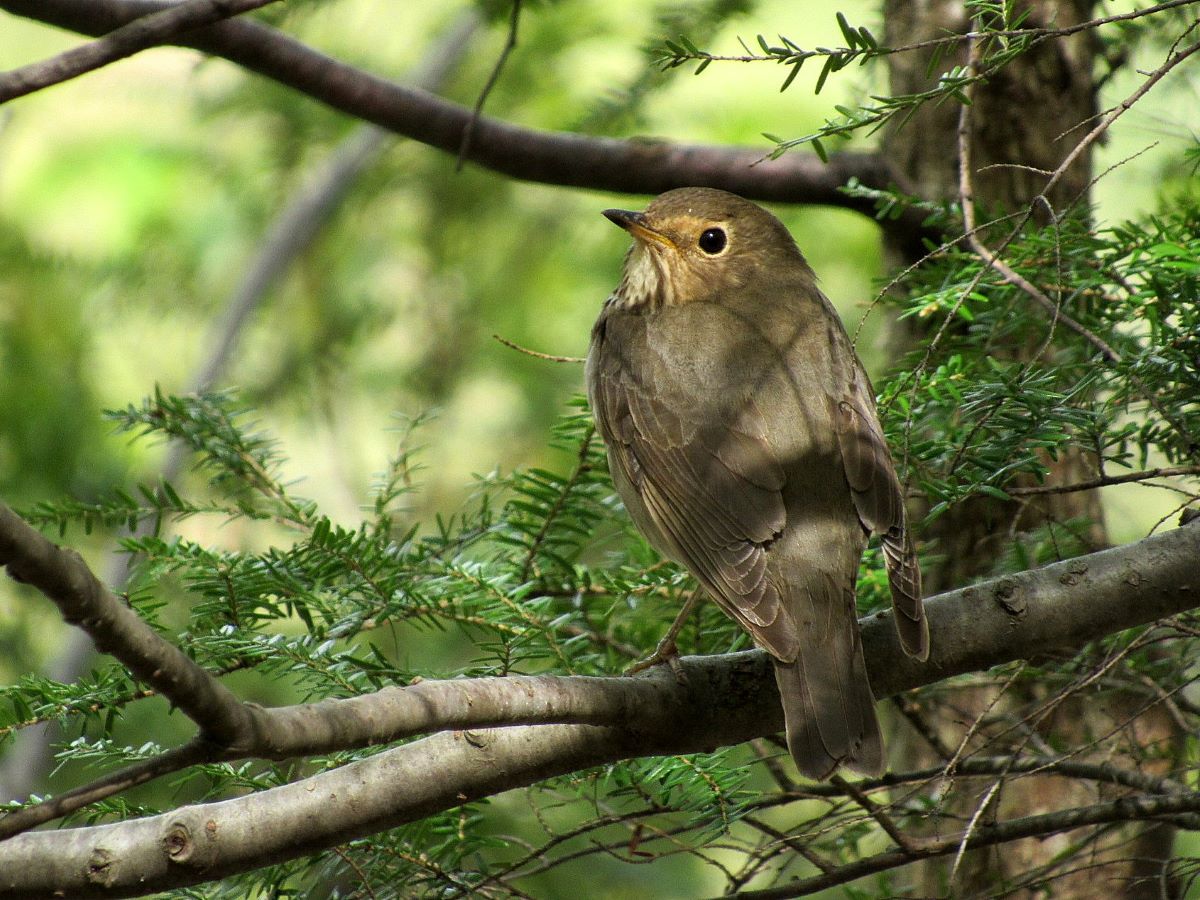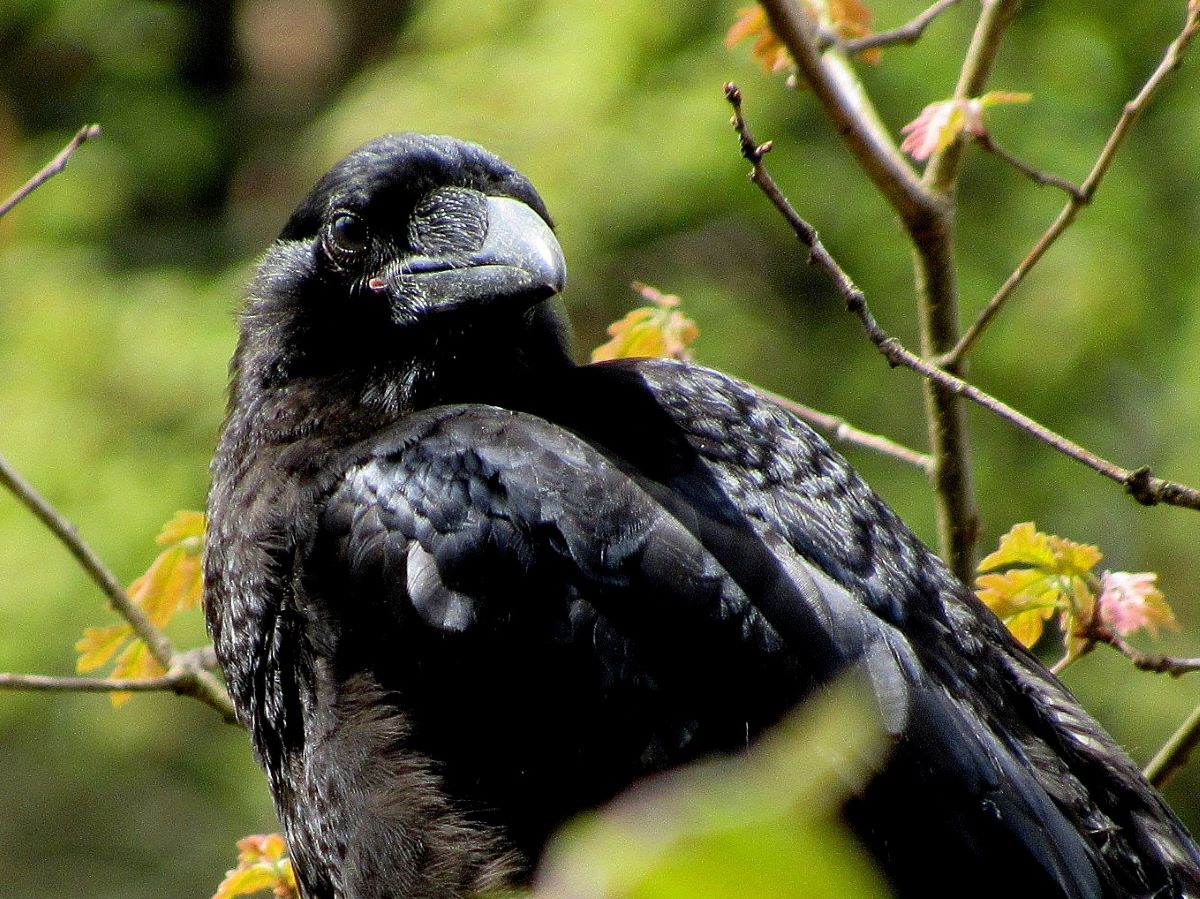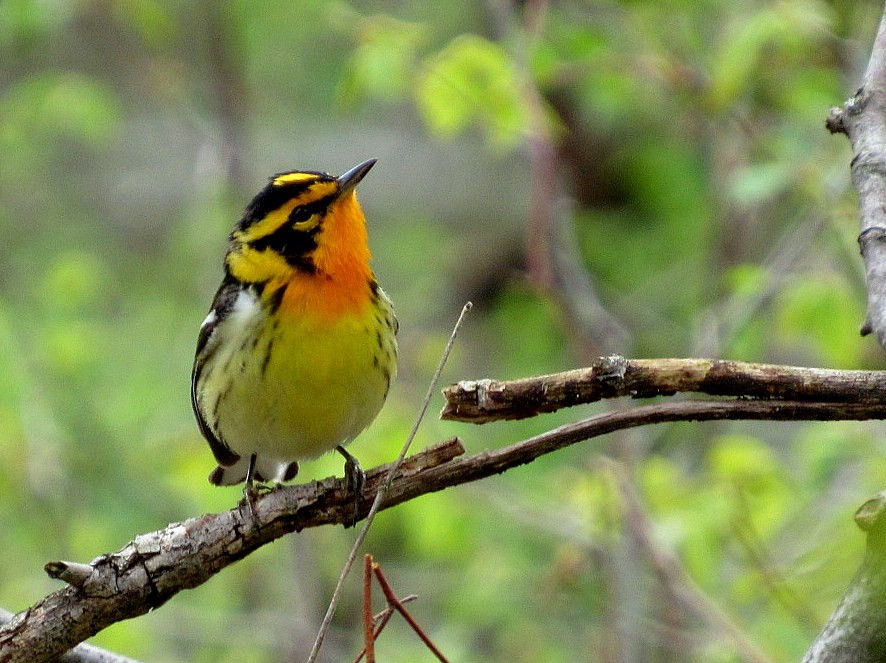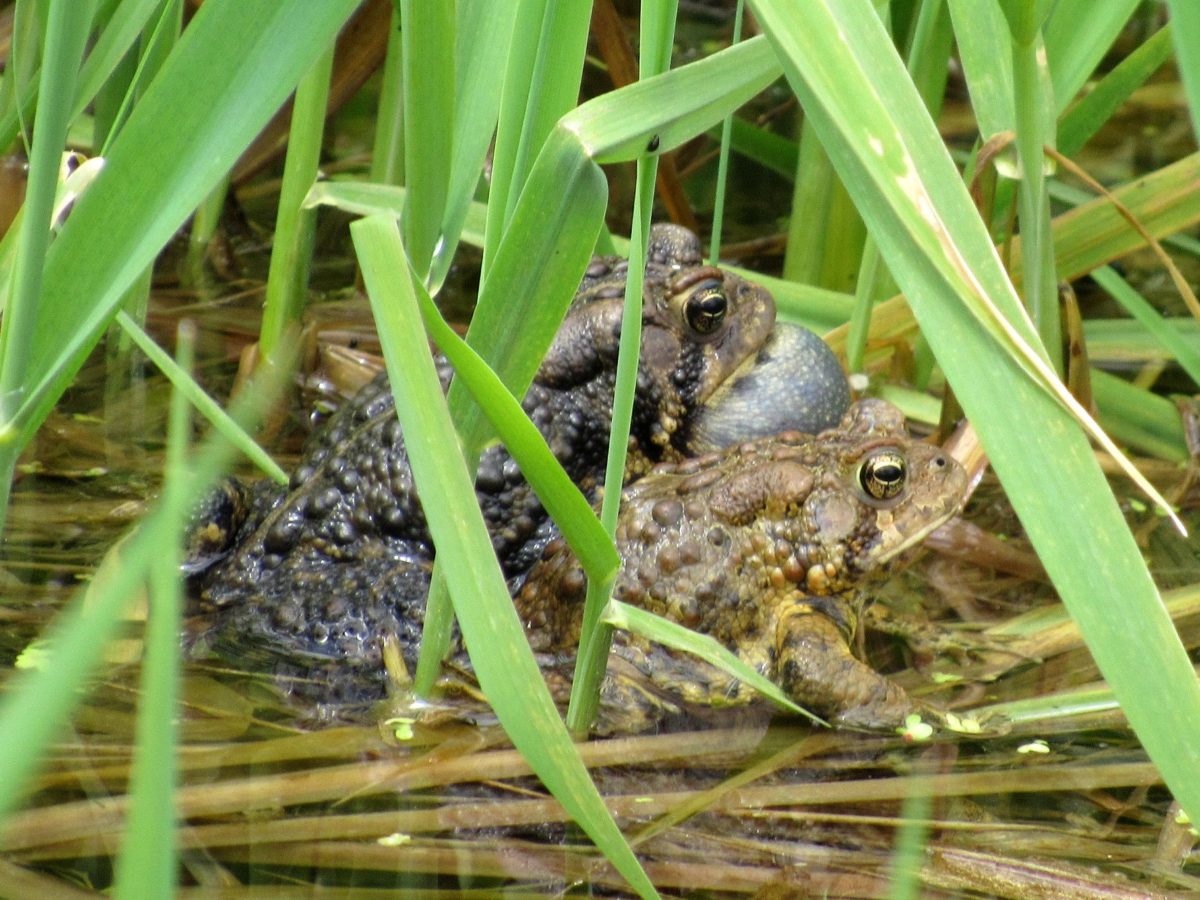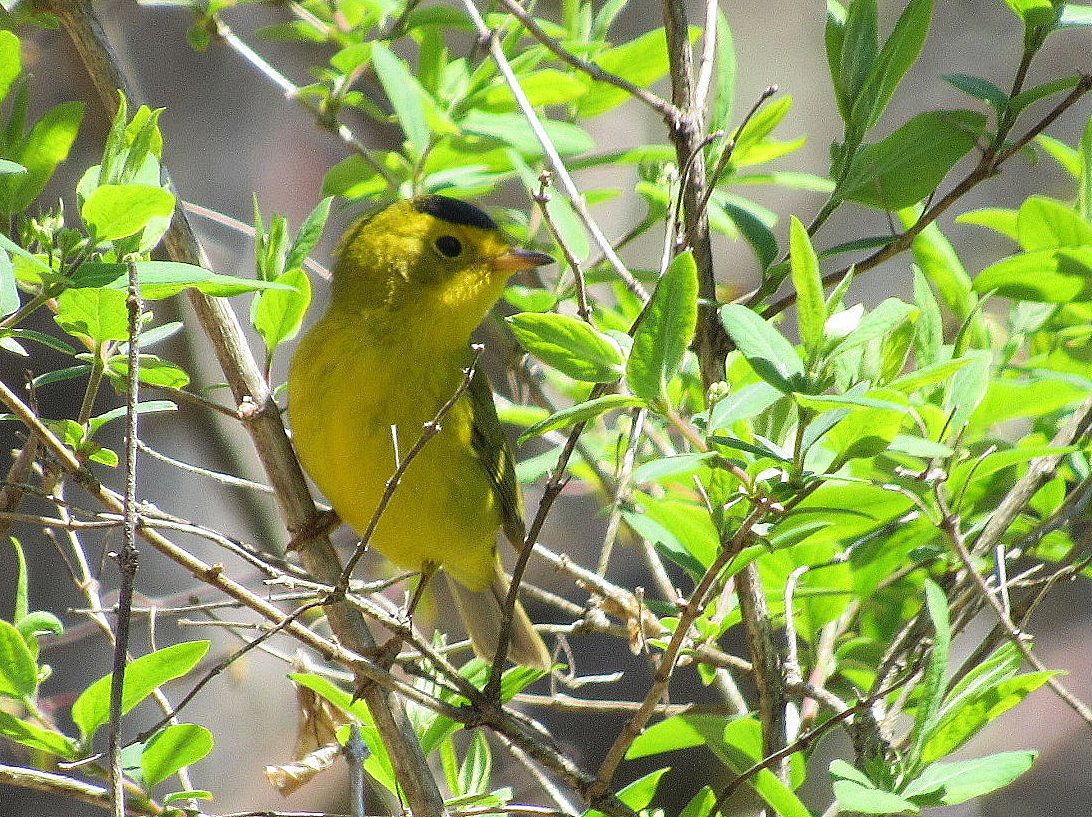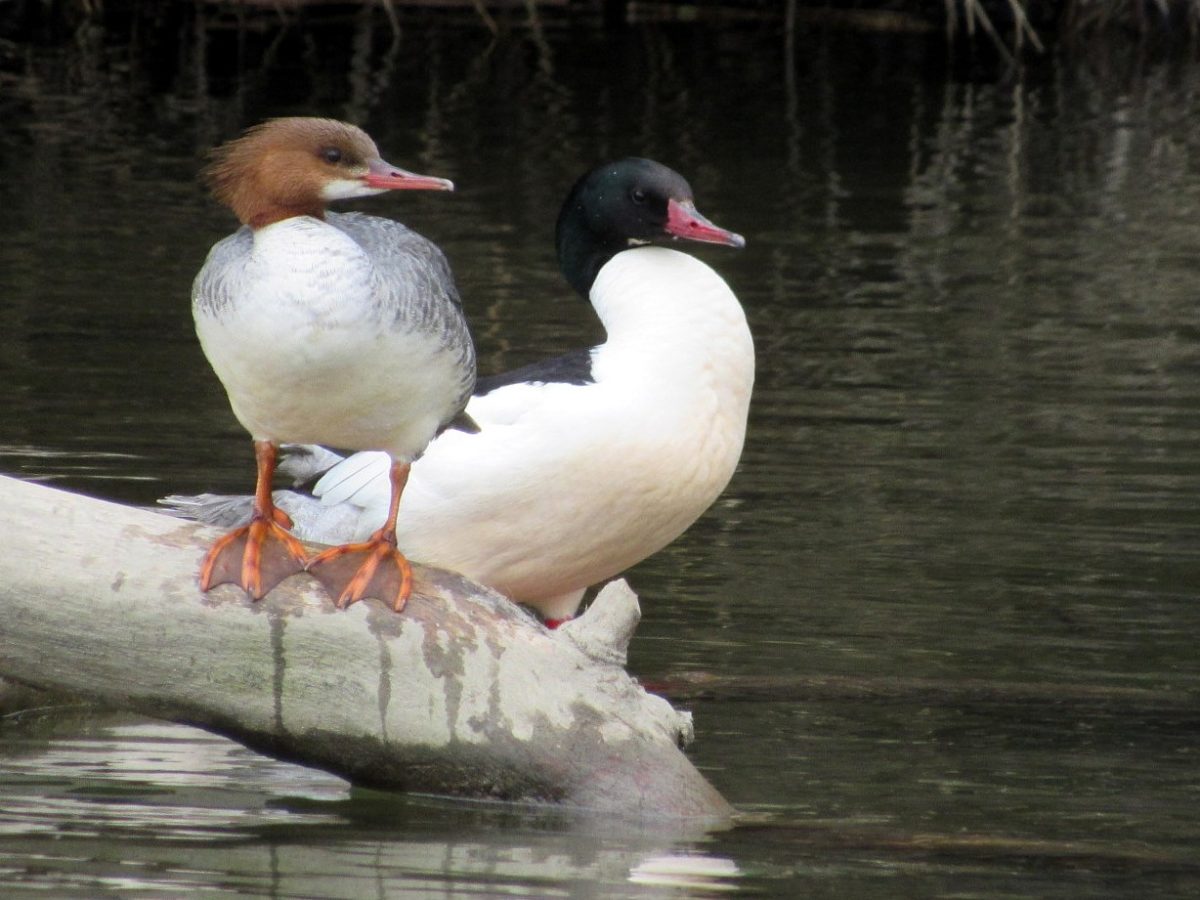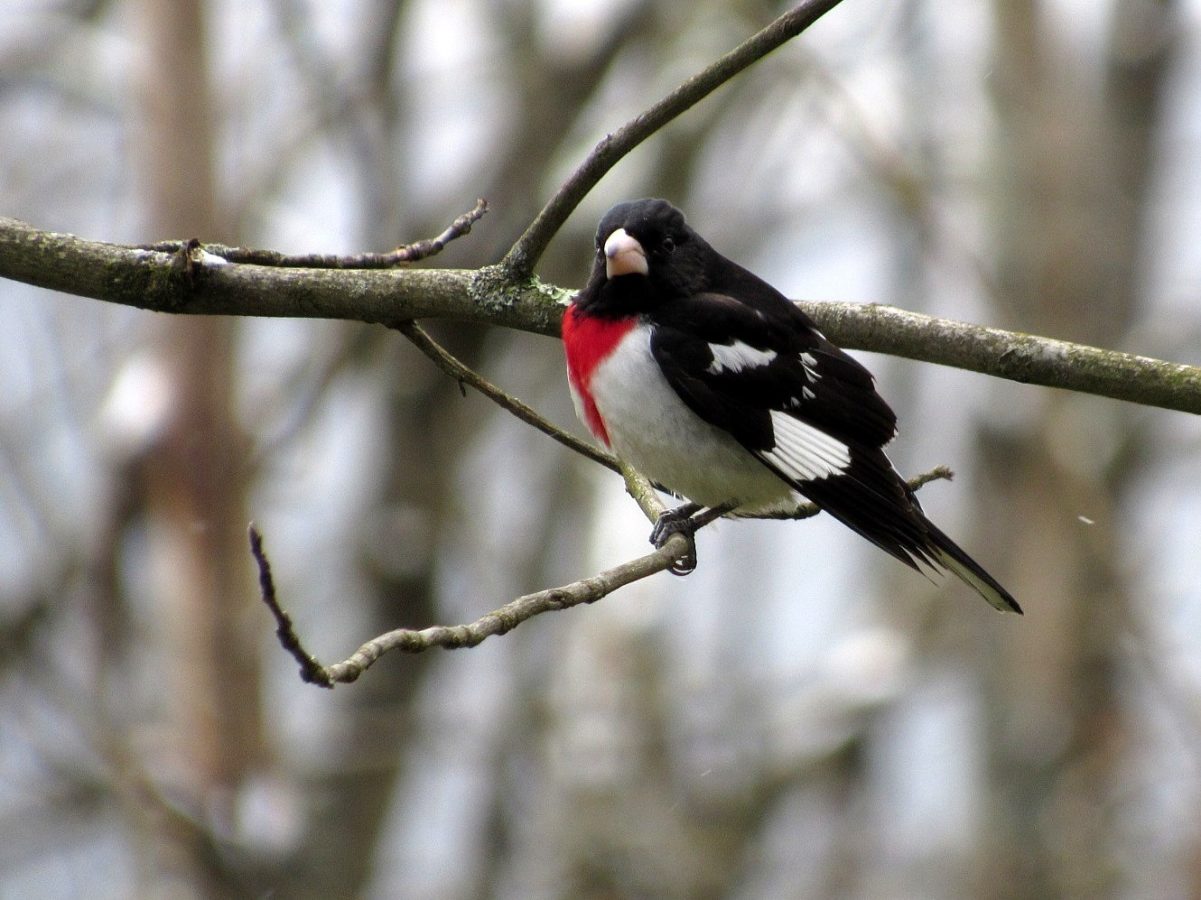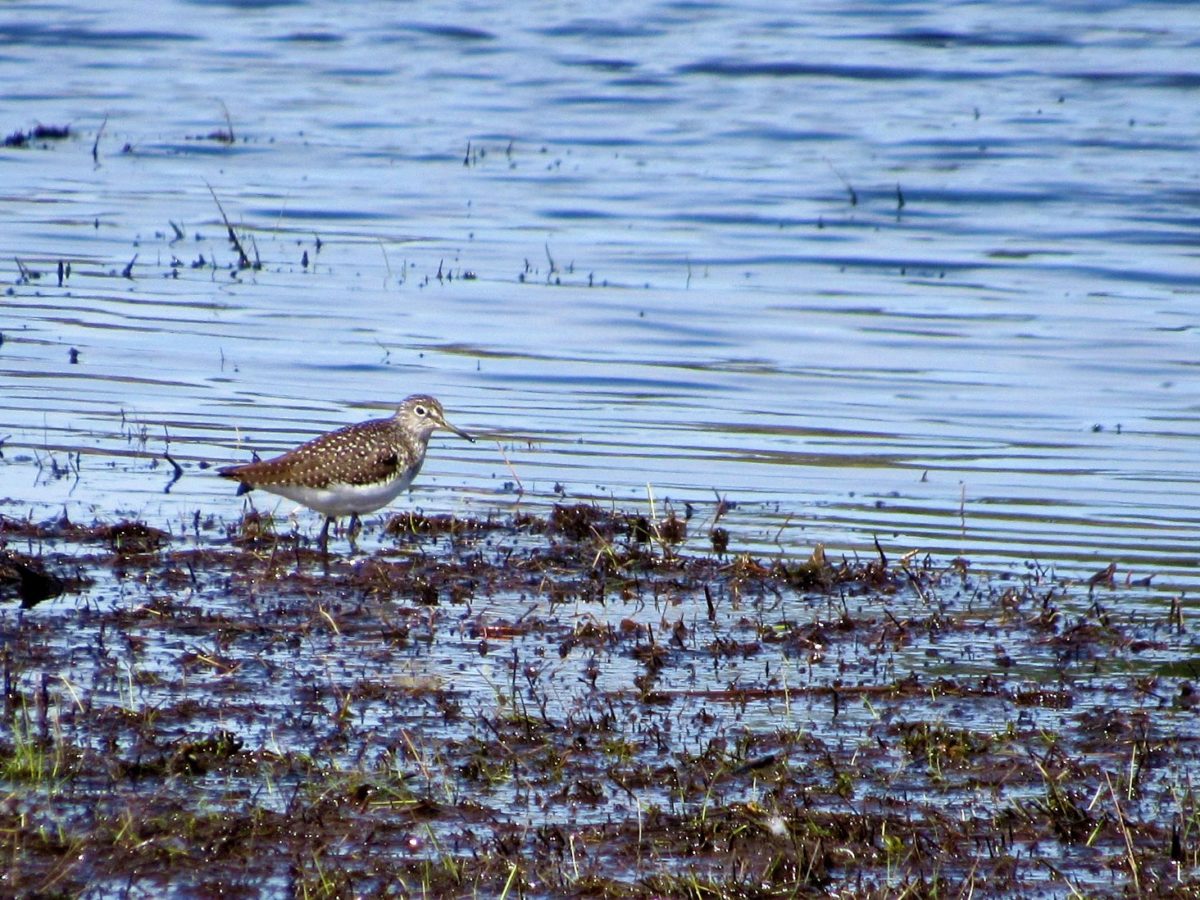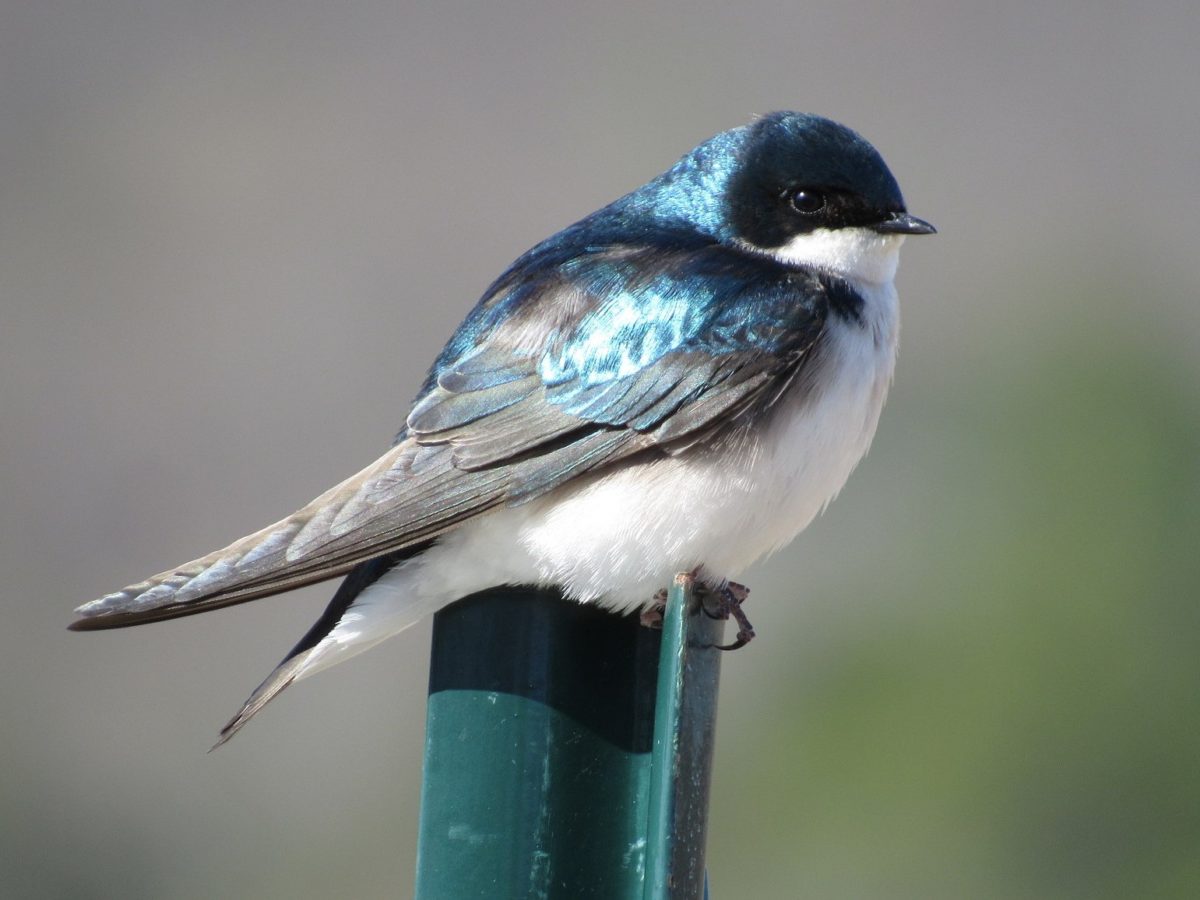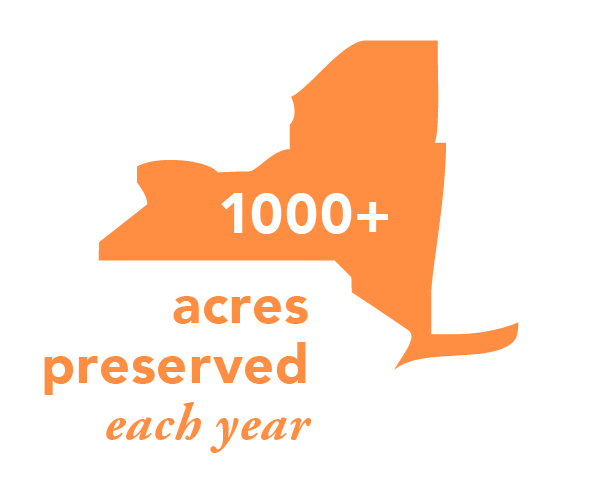Read a special message from Mark Chao about Spring Bird Quest 2020.
Saturday, May 30 and Sunday, May 31
After six days of very warm weather, spring migration seems to be essentially over. Now we are in the heart of the breeding season, as recent arrivals are busy finding territories, pairing up, and building nests, while those birds that arrived earlier are already raising young.
Miyoko, Tilden, and I visited the Goetchius Wetland Preserve again on Saturday. The vegetation in the grassland and marsh have become tall and less passable, so we didn’t venture in very far, out of reluctance to trample the habitat. But we did turn up a calling Black-billed Cuckoo and eked out an Eastern Kingbird (one last SBQ pun – not planned), which I somehow missed on all my other Land Trust outings in May.
And on Sunday, the last day of this modified SBQ, I got a message from Suan Yong about a very exciting bird in Mary’s Woods, which is in the southern part of the Goetchius Wetland Preserve, accessible from the Caroline Grove Cemetery on Route 79. I dropped everything to go chase this bird, but alas, didn’t find it. But at least Suan got a great photo – a red-morph Eastern Screech-Owl. He says it was almost within touching distance.
Eastern Screech-Owls are usually very difficult to see by day. I think that they may come out into the open by daylight more in late spring, when they’re crowded out of their nest cavities by growing babies, and when they might be more inclined to ramp up their foraging with more mouths to feed. This owl is in cryptic posture, which many owl species adopt to enhance their camouflage when they feel they’ve been seen – in this case, a futile attempt, given the color contrast between plumage and tree bark. (Screech-owls come in both gray and red morphs. Red screech-owls like this one are more common to our south, but rare in our area.)
Great find, Suan!
In the end, my month-long Spring Bird Quest species tally reached 118, accumulated on 22 visits to 11 preserves.
Campbell Meadow, Dryden: 3 visits, 46 species
Etna Nature Preserve, Etna: 1 visit, 29 species
Genung Nature Preserve, Freevillle: 5 visits, 70 species
Goetchius Wetland Preserve, Caroline: 5 visits, 66 species
Kingsbury Woods Conservation Area, Danby: 1 visit, 35 species
Lindsay-Parsons Biodiversity Preserve, West Danby: 1 visit, 49 species
Logan Hill Nature Preserve, Candor: 2 visits, 65 species
Dorothy McIlroy Bird Sanctuary, Summerhill: 1 visit, 41 species
Roy H. Park Preserve, Dryden: 1 visit, 41 species
Salmon Creek Bird Sanctuary, Lansing: 1 visit, 37 species
Sweedler Preserve at Lick Brook, Ithaca: 1 visit, 19 species
Donations are still coming in (and are still most welcome at fllt.org/donate), but already I think we can project a gift total to the Land Trust of at least $4,000, well within the usual SBQ range. Many thanks to all who have given, who are considering a SBQ donation now, and who have been supporting the Land Trust already.
I’ve had so many great experiences on Land Trust properties this month…I thank you very much for letting me share some of them with you. Most of all, I thank the Land Trust for all of its work in preserving these lands and many more throughout our region, for us people and the birds we love.
Monday, May 25
I had two brief outings to Land Trust preserves on Memorial Day. In the late morning, Miyoko and I visited the Salmon Creek Bird Sanctuary in Lansing, where we found the expected excellent variety of forest-edge and forest-interior birds, including Hooded, Blue-winged, and Chestnut-sided Warblers, plus several Yellow-throated Vireos and many Rose-breasted Grosbeaks and Veeries.
Here we also had the opportunity to pay our Memorial Day respects to John Rouse, a Continental Army captain during the Revolutionary War, who is buried here in a roadside family plot.
The gravestone reads as follows.
In memory of Deacon John Rouse, a Revolutionary officer, who lived and died a devoted Christian and patriot, who departed this life January 19, 1834, aged 92 years, 1 month
According to the Ithaca Journal, Rouse was born in 1741 in Dutchess County. He enlisted in the revolutionary army in 1775, eventually rising to the rank of captain in 1777, when he marched his men north to resist the advance of General Burgoyne from Canada. He was present at Burgoyne’s surrender at the second Battle of Saratoga. Husband of Hannah Smith and father of ten children, Rouse moved to the Finger Lakes in 1814 to be near his daughter Mary and her family. Lansing was founded three years later.
Shortly after sunset, I decided to close the long weekend at the Goetchius Wetland Preserve in Caroline. There I found the bird surprise of the day – at least five male American Woodcocks calling and displaying. What a fine surprise to find them still courting in such good numbers, with apparently undiminished gusto! I even got sight confirmation of one woodcock in the waning light, as the bird flew right in front of me and then rose on rapidly whirring wings in its wheeling display flight.
Running SBQ tally: 117 species
Saturday, May 23 and Sunday, May 24
On Saturday, Miyoko and I went to the Dorothy McIlroy Bird Sanctuary in Summerhill, stopping briefly on the way at the Genung Nature Preserve.
One recurrent theme of the morning was variant bird songs.
- A Blue-winged Warbler singing a four-note song (zeeee-zaa-zaa-zaa) like a Golden-winged Warbler at Genung. We eventually had stunning views of this bird as he continued to sing the variant song, with only a few bouts of the usual two-note song mixed in (beee-bzzzzz).
- Several Chestnut-sided Warblers singing their low, rambly finch-like song, also at Genung. Considering this song together with the usual high “chichichichitooWEEoo,” I can’t think of any other species whose song variants are so different from each other.
- To compound the challenges, a nearby Yellow Warbler singing a song with the same emphatic cadence as the standard Chestnut-sided song, ending with a rise and fall instead of the Yellow Warbler’s usual rising “sweet-sweet-sweet-I’m so SWEET!”
- As expected, many vocal Black-throated Green Warblers were in the hemlocks at the McIlroy Bird Sanctuary, almost all singing their unaccented-ending songs (zoo-zeee-zoozoo-zee), which are associated with territorial defense. Just a couple of weeks ago, almost all the Black-throated Greens I heard were singing their accented-ending songs (zeezeezeezeezee-zoo-zee), which they use to attract mates.
- At the McIlroy Bird Sanctuary’s southern border along Peth Road, we witnessed a long sing-off between two Savannah Sparrows in a single tree, one singing normally and the other omitting the usual sad-sounding note after his trill, rather like a Grasshopper Sparrow. It seemed that they dueled to détente – each retreating to his own field, one to the north and one to the south, with the tree itself serving as a DMZ between them.
Our other Saturday bird drama also unfolded along Peth Road. Miyoko spotted a big brown lump in the first green field, less than ten meters away and completely out in the open, but we couldn’t figure out what it was. A log? A snapping turtle? Then, the shape burst up from the ground and with labored flaps revealed itself as a Wild Turkey hen. We think that she might have been flattening herself down over a nest site, though we could not figure out why she would pick somewhere so open, nor could we find any eggs or chicks.
On Sunday, upon hearing some options of where we might go, both Tilden and Miyoko decisively opted for a repeat visit to the Logan Hill Nature Preserve. There, as expected, we found an excellent variety of breeding songbirds (including fine looks at Hooded Warbler, Chestnut-sided Warbler, American Redstart, and Blue-headed Vireo), plus a couple of passage migrants (Swainson’s Thrush and Tennessee Warbler). Throughout the morning, we also got many wonderful views of common butterflies, including our first Eastern Tiger Swallowtail and Juvenal’s Duskywing of the year, plus an obliging Eastern Comma.
- Eastern Tiger Swallowtail photo by Mark Chao
- Juvenal’s Duskywing photo by Mark Chao
- Eastern comma photo by Mark Chao
- Eastern comma photo by Mark Chao
The surpassing highlight of the morning came from five Chimney Swifts, which first zoomed and banked in close formation and exhilarating synchrony over the fields and across the sky, like an avian version of the Blue Angels, then descended to the pond to drink on the wing, skimming the surface with their little bills, all while hardly losing any airspeed. For a family used to watching Chimney Swifts over downtown Ithaca but not elsewhere, it was a revelation to witness this species’ wildness up close, in their natural habitat beyond our world of metal, concrete, and glass.
Running SBQ tally: 114 species
Sunday, May 17 and Tuesday, May 19
On Sunday, Miyoko and I visited the Lindsay-Parsons Biodiversity Preserve in West Danby for the first time in 2020. The warbler numbers lived up to the preserve’s reputation as one of the best local sites for warbler-watching throughout May. We ended up with 13 species, including the first Hooded Warbler of this SBQ, plus fine looks at singing Prairie Warbler and Blue-winged Warbler.
The highlights here came, a bit unexpectedly, from other songbirds. We witnessed master classes from two separate Brown Thrashers – a virtuosic singing recital atop a bare tree, and a tadpole-sashimi preparation demo right in the middle of the mowed trail. The latter spectacle, though grisly, was etymologically enlightening, as it was the first time I’ve ever seen a thrasher actually thrashing something. We also got splendidly picturesque views of a lone Cedar Waxwing among the gnarled branches, young leaves, and little pink flowers of a crabapple tree.
Then on Tuesday, I decided to pay my first visit to the Kingsbury Woods Conservation Area along Jersey Hill Road in Danby. Sheela Kingsbury donated these 48 acres to the Land Trust in 2008. The preserve comprises mature woods (portions of which were downed by a tornado in 2011) and 6000 feet of frontage along the serene glittering waters of upper Lick Brook.
The bird highlights here came after a long but quiet walk in the woods, as I returned to the parking area. Here I found a Winter Wren, a much-coveted first for this year’s SBQ, singing territorially from a surprisingly high perch on a bare snag. Then I found the month’s second improbable American Dipper act (see my May 10 post from Campbell Meadow) – this time, from a Swainson’s Thrush standing out on streamside rocks and even wading into the brisk current.
- Winter Wren photo by Mark Chao
- Swainson’s Thrush photo by Mark Chao
Finally, I made a quick late-morning stop at the Sweedler Preserve at Lick Brook. Here I found my target species, a singing Louisiana Waterthrush. I also had dazzling views of a Swainson’s Thrush (this one acting much more normal, perching in the shadows and foraging on the forest floor), and two fledgling Common Ravens (looking a lot like adults, with only traces of gray down and barely visible yellow gapes at the corners of their mouths).
Running SBQ tally: 108 species found across nine preserves
Friday, May 15 and Saturday, May 16
The weather finally turned on Thursday night, bringing south winds and the month’s first strong influx of migrant birds. I spent most of Friday and Saturday mornings seeing what had turned up at four Land Trust preserves. Here are some highlights.
Roy H. Park Preserve, Dryden (Friday)
- 16 warbler species, including the first Cape May, Prairie, Canada, Nashville, and Tennessee Warblers of this year’s SBQ.
Genung Nature Preserve, Freeville (Friday and Saturday)
- 13 warbler species, including Blue-winged and Pine (excellent sightings shared with Nita Irby on Friday), and Blackburnian (brief but electrifying views of two males, shared with Miyoko and Tilden on Saturday)
- My first Swainson’s Thrush sighting of the year, also shared with Miyoko and Tilden
- An adult Broad-winged Hawk overhead, trying to dodge attacks from an American Crow
- A pair of Blue Jays building a nest together right along the trail.
Etna Nature Preserve, Etna (Saturday)
- A Spotted Sandpiper along Fall Creek. I spied this bird as it flew with shuddery wings across Fall Creek. I then helped Miyoko and Tilden to get on the bird as it teetered on a log and offered fine views of its orange bill and mottled plumage. (“Well spotted,” Tilden dad-punned.)
Campbell Meadow, Dryden (Friday and Saturday)
- Two Spotted Sandpipers and a Solitary Sandpiper on a bar of mud in the creek on Friday. After strong thunderstorms, this bar was inundated by fast-flowing muddy water by Saturday.
- Northern Parula and Nashville Warbler on Saturday (the first obvious passage migrants I’ve found here besides Yellow-rumped Warbler)
- A breeding aggregation of American Toads, spanning a dazzling range of color (from light tan to the blackest I’ve ever seen in an adult of this species), size (from normal to huge), and sound volume (rising from silence to an intense unison fortissimo, then fading back again). Many of these toads were in amplexus, with males clamped onto the backs of females. We also witnessed a four-toad scrum.
Running SBQ tally: 100 species
Tuesday, May 12 and Wednesday, May 13
In 2005, Mildred Sherwood donated her 53-acre former family farm to the Land Trust in memory of her parents, Albert and Mildred Genung. With her approval, the Land Trust then transferred the land to the Village of Freeville, subject to a conservation easement held by the Land Trust. This land, comprising tall pines and the sunny riparian corridor along a deep looping bend in Fall Creek, is now known as the Genung Nature Preserve.
I visited this preserve on Tuesday and Wednesday mornings. Despite continued unseasonably cold weather (so cold indeed that that the National Weather Service issued freeze warnings on both Monday and Tuesday nights), I had my first really good warbler-watching of the season – 12 species and many high-quality views, especially in areas of the most direct sun exposure. The warbler species list: Wilson’s (uncommon in our region but present both days), Pine, Chestnut-sided, Black-throated Blue, Palm, Yellow, Yellow-rumped, Blue-winged, American Redstart, Common Yellowthroat, Ovenbird, and Northern Waterthrush.
Key numbers from these visits: 54 species over almost five hours (mostly spent trying vainly for good photos of flitting birds)
Running SBQ tally: 85 species
Sunday, May 10
Campbell Meadow is a public preserve owned by the Town of Dryden, subject to a deed restriction held by the Land Trust. Located at the intersection of Lower Creek Road and Pinckney Road, the site comprises a wet grassy field and scattered trees in the floodplain of Fall Creek, with scenic creek frontage and about a mile of mowed trails. Miyoko and our son Tilden Chao joined me here for a Mother’s Day morning walk.
We picked up three sparrow species new for this year’s SBQ — White-crowned Sparrows, a relatively uncommon passage migrant that will be absent from our area in a couple of weeks; a House Sparrow in one of the Tree Swallow boxes; and a pair of Chipping Sparrows offering very close views by the parking area. We also enjoyed a wonderful reprise of our previous SBQ encounters with nesting Tree Swallows and at least two singing Rose-breasted Grosbeaks.
At the creek’s edge, we saw a pair of Common Mergansers drifting downstream and then pausing for several minutes to preen. Nearby on the bank, two Yellow Warblers darted through the long grasses and along the muddy shore with tireless urgency, apparently finding insects and/or maybe finding fibers for a nest. When they perched on the wet rocks, they looked improbably like American Dippers with colors wildly remapped, as if by Andy Warhol.
Key numbers from this visit: 30 species and 134 individual birds over 1 hour and 0.6 miles of walking
Running SBQ tally: 67 species
Saturday, May 9
This week’s long and severe cold spell has somehow gotten even worse today around the Finger Lakes, as the polar vortex has brought howling winds, a couple of inches of snow, and a mass of frigid Arctic air that’s not going to warm up past 40°F until tomorrow.
Nevertheless, my wife Miyoko Chu and I decided this morning to bundle up and head out to the Logan Hill Preserve in Candor to look for birds. And what do you know – it turned out to be a day worthy of any optimist’s high May 9 hopes – full of birds and even a little sunshine.
- A male Rose-breasted Grosbeak singing his smooth twirly song along upper Water Street, completely undeterred by the cold, and another that offered us a brief but stirring close view further up Logan Hill Road.
- A flock of songbirds in the hemlocks, including singing Northern Parula, Black-throated Blue Warbler, a few Black-throated Green Warblers, many male Yellow-rumped Warblers, and at least one Blue-headed Vireo. (Note that in February 2020, the Land Trust expanded this wooded portion of the preserve with a 63-acre purchase, bring the preserve to a total of 348 acres.)
- Singing Blue-headed Vireo and Yellow-throated Vireo along the easternmost stretch of the yellow-blazed trail.
- A pair of Eastern Towhees together in the brush along the east-west portion of Logan Hill Road, plus a few others calling elsewhere
- A Brown Thrasher foraging on this same stretch of road
- And the highlight of the morning – an adult Bald Eagle that circled twice overhead, issuing piercing short vocalizations, alighted at the tip of bare snag in a moment of full sun, and then flew off with a long stick, back toward Catatonk Creek.
Key numbers from this visit: 36 species and 120 individual birds over 3 hours and 3.3 miles of walking
Running SBQ tally (bird species found on Land Trust properties so far in May): 59 species
Tuesday, May 5, 2020
Today I visited the Finger Lakes Land Trust’s Goetchius Wetland Preserve. I found a satisfying subset of the species that others found this past weekend (no Sedge Wren), plus one unexpected new visitor. Here are some highlights.
- Peregrine Falcon overhead, speeding northbound into the wind. An exciting surprise, and maybe unprecedented for the Spring Bird Quest! My brief view and one bad photo do not show dangling jesses, but the bird’s feet appeared to be balled up on something. I’ve tried to determine if someone was taking a captive falcon out for sport here, but haven’t heard anything so far. So I think that this was a wild bird, countable for the SBQ.
- Virginia Rail grunting spontaneously in the middle of the southernmost cattail patch accessible by foot from the parking area. (Others found up to seven Virginia Rails, three American Bitterns, and a Sora here on Saturday and Sunday.)
- Two Wilson’s Snipe issuing rich chirps at rest from the cattails, then rising up and wheeling spectacularly together in the blue sky
- Solitary Sandpiper in the original southern portion of the preserve, in a close mud patch surrounded mostly by open water
- Brown Thrasher teed up and singing a loud, varied, and wonderfully musical song in a hedgerow in the newest part of the preserve (acquired in January 2019) on the east side of Flatiron Road, with Eastern Bluebird, Yellow Warbler, and Purple Finch singing nearby
- Bobolink, Eastern Meadowlark, Savannah Sparrow, and Field Sparrow all singing (though not often, except the Field Sparrows) in the northern section
- Wonderful views of Tree Swallows perched by their nest boxes, perhaps seeking to let solar radiation make up for the scarcity of insects and resultant caloric deficit on this very cold day.
The Land Trust has painstakingly pieced the preserve together over the years. It made the first two acquisitions in 1995, a total of 36 acres. Since then, via three more acquisitions, the Land Trust has acquired the wetlands and open fields to the north (2007 and 2011) and the new wet meadows and hedgerows to the east (January 2019), more than doubling the preserve’s original size.
Key numbers from this visit: 36 species and 108 individual birds over 1.25 hours and 1.4 miles of walking

